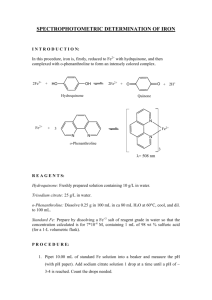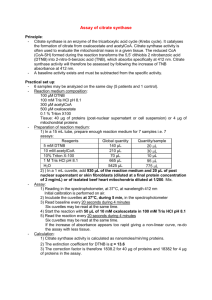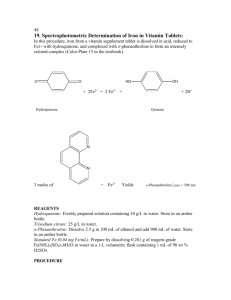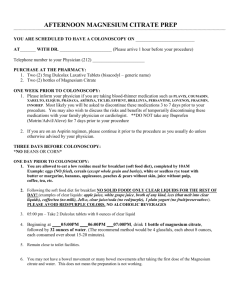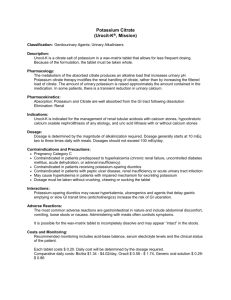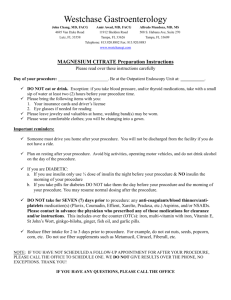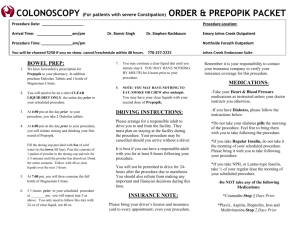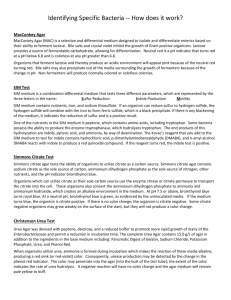View/Open - YorkSpace
advertisement
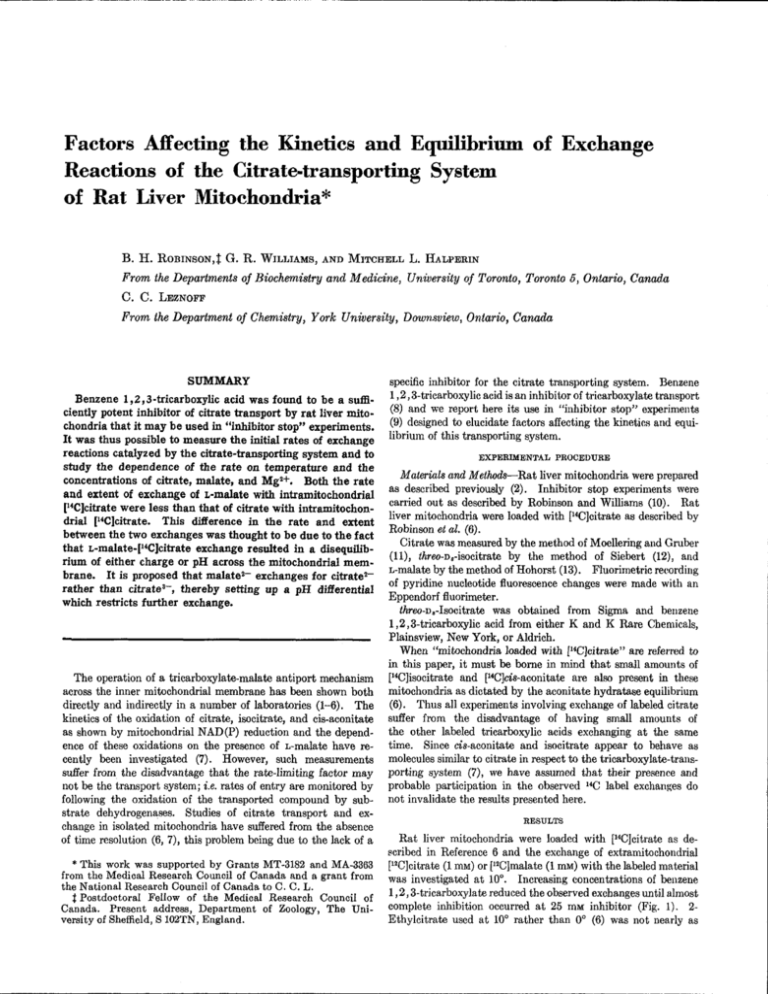
Factors Affecting the Kinetics and Equilibrium of Exchange
Reactions of the Citrate-transporting System
of Rat Liver Mitochondria*
B. H. RosrNsor.l,f G. R. Wrr,r,raus, aND Mrrcnnr,r, L. Elar,pnmN
From the Departments of Bi.ochwnistry and Med'icine, Uwiuersity of Toronto, Toronto 5, Ontnri.o, Canada
C. C. Luzronn
From the Depofirnent of Chernistry, Yorlc Un'iaersity,
ST'I[MARY
Benzeue Lr2r3-tricatboxylic acid was found to be a sufrciently poteut inhibitor of citrate kanslort by rat liver mitochondria that it may be used in "inhibitor stop" experimeuts.
It was thus possible to measure the initial rates of erchange
reactious catalyzed by the citrate-transporting system and to
study the dependeace of tle rate on temperature and the
concentrations of cikate, malate, and Mg2r. Botl the rate
and extent of exchange of l-nalate with intramitochondrial
faClcitrate were less than that of citrate with intramitochondrial [t{Clcihate. This difrerence in the rate and extent
between the two exchanges was tlought to be due to the fact
that r,-malate-faC]citrate erchange resulted in a disequilibrium of either charge or pII across the mitochondrial membrane. It is proposetl that malate2- exchanges for citrate2-
rather than citrates-, thereby settiag up a pH differential
which restricts further exchange.
The operation of a tricarborylate-malate antiport mechanism
the inner mitochondrial rnembrane has been shown both
directly and indirectly in a number of laboratories (1-6). The
kinetics of the oxidation of citrate, isocitrate, and cis-aconitate
as shown by mitochondrial NAD(P) reduction and the dependence of these oxidations on the pres€nce of r,-malate have reacross
cently been investigated (7). However, such
measurements
from the disadvantage that the ratcJimiting faetor may
not be the transport system; i.e. ra.tes of entry are monitored by
following the oxidation of the transported compound by substrate dehydrogenases. Studies of citrate transport and exchange in isolated mitochondria have sufiered from the absence
of time resolution (6, 7), this problem being due tn the lack of a
su.frer
* Tbis work was supported by Grants MT-3182 and MA-3363
from the Medical Research Council of Canada and a grant from
the National &esearch Council of Canada to C. C. L.
f Postdoctoral Fellow of the Medical Research Council of
Canada, Present address, Department of Zoology, The University of Sheffield, S 102TN, England.
Dawn,sui.ew,
}n.torio, Cannda
specific inhibitor for the citrate transporting system. Benzene
I ,2 ,3-tricarboxylic acid is an inhibitor of tricarboxylate transport
(8) and we report here its use in "inhibitor stop" eraeriments
(9) dasigned to elucidate factors afiecting the kine;bics and equilibrium of this transporting system.
EXPEBIMENTAL PROCEDURE
Materi,als anl, Melhpds-Rat liver mitochondria were prepared
as described previously (2). Inhibitor stop experiments rvere
carried out as described by Robinson and Williams (10). Rat
liver mitochondria were loaded rvith [taC]citrate as described by
Robinson el,al. (B).
Citrate was mea,sured by the method of Moellering and Gruber
(LL), threo-o,-isocitrate by the method of Siebert (12), and
r,-malate by the method of Hohorst (13). Fluorimetric recordirrg
of pyridine nucleotide fluorescence changes were made with an
Eppendorf fluorimeter.
llrreo-n"-Isocitrate was obtained from Sigma and berrzene
1,2,3-tricarborylic acid from either K and K Rare Chemicals,
Plainsview, New York, or Aldrich.
When "mitochondria loaded with {1aC]citratc" &re referred to
in this paper, it must be bome in mind that smaJl amounts of
faC]isocitrate and [1aC]crls-aconitate are also present in these
mitochondria as dictated by the aconitate hydratase equilibrium
(6). Thus all experiments involving exchange of labeled ciirate
suffer from the disadvantage of having small amounts of
the other labeled tricarboxylic aeids exchanging at the same
time. Since cr,'s-aconitate and isocitrate appear to behave as
molecules similar to citrate in respect to the tricarboxylate-transporting system (7), we have assurned that their presence and
probable participation in the observed ilC labe.l exchanges do
not invalidate the results presented here.
RESULTS
Rat liver mitochondria were loaded with [raCJcitrate as described in Reference 6 and the exchange of extramitochondrial
(1 mrvr) or ['2C]malate (1 mu) with the labeled material
was investigated at 10". Increasing consentrations of benzene
| ,2,}-tricarboxylate reduced the observed exchanges until almost,
complete inhibition occurred at 25 mnr inhibitor (Fig. 1). 2Ethylcitra.te used at 10o rather than 0o (6) was not nearly as
[l'C]citrate
r00
|
80
=50
=
h
I
=
F
=
t\
=30
E.
l!J
u{0
I
-
be
2.0
[\
t
(m
inut crl
Frc. 2. Time course of citrate-[uCJeitrate and malate-[l{]citrate exchanges aB measrued by inhibitor stop technique. See
text for description of experiment. a-4, 1 mu citrate;
O-O,l
05101520
SEllZtllt l2!
TRICARB0XYLATE
(mfrll
Fre. l. Benzene 1,2,3-trioarboxylate inhibition of citratelr.C]citrate and malate-[1'C]citrate exchange. Rat liver mitochondria (samples containing 8 mg of protein) loaded with FCIcitrate were added to l-ml incubations of a medium oontaining
125 mu KCl, 20 mrrr Tris Cl (pH 7.4) at 10". Increasing concentrations of benzene l,2r8-tricarboxylate were included in the
incubations with either I mlt citrate or 1 mu ma,late. After
standing for 2 min the mitochondria were separated by centrifuga-
tion and the supernatants were deproteinized and evacuated as
described in Reference 6 and counted for [trg1.ittate. An unseparated sample was also treated and counted to allow calculations of the total ll{C]citrate in the system. Control incubations
with no citrate or malate added extramitochondrially were also
included. The extent of exchange over the time period wed was
expressed as perceuta.ge exehange
(6). This is defined
as:
Supernatant disintegrations per min in incubation
- supernatant disintegrations per min in control incubation
mitochondrial disintegrations per min in control inoubation
xa
100
a-a,
I
mra
citrate;
A-A,
1
mu r,-malate.
effective an inhibitor a,s benzene 1,2,3-tricarboxylate. Benzene 1;2,3-tricarborylate (50 mu) gave complete inhibition of
both citrate-[raC]citrate a,nd r-mB.la,te{lClcitrate exchange. It
is interesting to note tbat 50Vo inhibition of exchange ocoured
at about 3 mru inhibitor for both these exchanges.
Ratn o{ Exchnnge-Having established the fact that 50 mu
inhibiior was capable of fully stopping the exchange, it was
decided to follow tbe time cowse of exchanges mediated by the
citrate-transporting system using the inhibitor stop technique.
Incubations rvere performed a{, 10o, the exchanges being started
by the addition of [r€]eitrate-loaded mitochondria to 1-ml
incubations of KCI-Tris-Cl buffer containinE either I rnM un-
mrc r,-malate.
labeled tricarboxylate anion or 1 mnr r,-malate. After time
intervals of 0 to 2 min the exchange was terminated by the
rapid addition of benzene 1 ,2 ,3-tricarboxylate to 50 mm and the
supernatant was separated by centrifugation. After treatment
with perchloric acid, ueutralization with potassium
carbonate,
and evacuation over KOH to remove l.COz (6), samples of the
superna,tant rvere counted as desuibed previously (6). An
uncentrifuged sample of mitochondria was treated in a similar
m&nner to allow estimation of the total [lC]ciirate in the system.
Fig. 2 shows the tirne course of citrate-[raC]citrate and malate[raC]citrate exchanges with 1 mu [t2Cjcitrate or r-malate present
extramitochondrially. Both the ra.te and extent of citrate[taC]citrate exchange exceeded that of r-malate{r{lcitrate
exchange, although the ratp varied from 1.9 to 6.8 nmoles per
min per mg of protein for malate-[1aC]citrate exchange and 3.5
to 8.0 nmoles per min per mg of protein for citrate-[trf,]citrate
exehange at 10o.
When the variation of the rate of L-malate-['aC]citrate exchange
with temperature *'as investigated by following the time courses
of the exchange with the inhibitor stop technique, it was found
that the rate of exchange approximately doubled for every 5o
rise in temperature over a range from G-20" (Fig. 3). The
initial rate of exchange at 20o for 1 mnr l-malate with [r{C]citrate
in this experiment lvas 27 nmoles per min per mg of pmtein. A
doubling in rate for every 5" increase was also found for citrate[1{C]citrate exchange.
The concentration dependence of the initial rate of citrateIr{Clcitrate exchange was determined by performing inhibitor
stops after exchange had been permitted to take place for L5
sec at varying substrate concentrations. Similarly, for r,-malate[r{C]citrate exchange, inhibitor stops with 50 mar benzene 1 ,2 , 3tricarboxylate were performed after 10 sec at varying r-malate
concentrations. This method of determining rates assumes
linearity of reaction up to the time of addition of the inhibitor
(see Fig. 2). This assrmption, although probably correct for
these exchanges at most, zubstrate concentrations, may be invalid
810
E
820
tr
i!
I
-
?.20
Xro
!c
t€
t (rccondcl
4201060
t
Frc. 5. The efrect of Mg!+ on the time course of citrate-[1tQ]-
(:ccondrf
Fro. 3. Temperature depondence of L-mala,te-[u0]c'trate excha.nge. Tbe experiment wae performed as described for Fig.2
with 1mu r-mslat€ as the exchanging anion at 0o (g-9;,
15" (1-1),
50 (o-1;,
10" (6-4;,
and 20o (tr-tr).
Mitoohondrial protein (9.1 mg) was added to each incubation and
the initial total intramitoehondrial citrate was 8.9 'moles per mg
of mitocbondrial protein.
citrate ond L-malate-[1rO]citrate exchange. The
experiments
for Fig. 2 with 1 mu r,malate (A-A) and 1 mu r.-malate plus 5 mu Mgr+ (g-9;
in .d and 1 mu citrate (A-A) and 1 mu citrate plus 5 mu Mgtt
(O-O) in -8. Controls were carried out in each experiment
with 50 mu benzene 1,2,3-tricarboxylate added a,t zero time with 1
mn r,-malate (A-A) and 1 mu r,-malate plus 5 mu Mg*
(a--a) in,4. and 1 mu citrate (A-A) and I mac citrate plus
5 mu Mg* (o--a) in B.
were carried out as described
t00
!so
ts
Foo
-E{0
I
1.0
S005IRlIl {llrtl
!e
5101,
l/
SUBSrtlI€ (ntl-t)
Frs.4. Tbe concontration depondence of the exchange of r,malate end citrate for flC]citrate. Rat liver mitochoadria (8
mg of protein) loaded with ll.C]citrate were rapidly pipetted into
l-ml incubations of KCI-Tris CI bufter at 10" containing various
conoontrations of citrate (O-O) or r,-malate 11-f
). After
l5 sec for citrate and 10 see for r,-malate the exchange was stopped
by the addition of 50 mM benzene 1,2,3-tricarboxylate and the
mitochondria were separated by centrifugation (10). The superna,ta,nts were deproteinized, evacuated, and counted as described
previously (10). / is a plot, of pereentage exchange against concentration while B is a plot of the reeiprocals of these value.
at low concentrations of r,-malate at which the extent of the
exchange at equilibrium may be small. Control incubations
performed with 50 mM benzene 1,2,3-tricarbo4ylate present at
zero time showed only slight exchange (>1.5%) at the highest
substraki concentration used. Again the maximum rate obtained with r,-malate (fig. a) was lower than that obtained with
citratp. Lineweaver-Burk plots of these data gave K- values
of 0.25 mM for citrate and 0.35 mrrt for r,-malate. The rates of
exchange of czs-aconitate and tireo-ou-isocitrate with [laC]citrate
slishtly exceeded that of citrate, and the K^ values were 0.22
mu for both these species. Similar K^ values were obtained
following the time courses at 50. The presence of 5 mu Mg*
20
0t02030{050
t.llAIATE {nM}
Fra,6. The dependence on r,-malate concentration of the
equilibrium position of mal&te-lt.C]citrate exchange. The ex-
perirnent was carried ouf as described in Table
I.
in the incubation medium
caused both the rate and extent of
r,-malate-faC]citrate exchange to be insreased (Fig. 5) while
decreasing the rate of citrate-frO]citrate exchange.
Entnnt of Etchan4e-4he exchenge of r-malate with [aC]citrate was investigated by allowing the added L-malate to exchange for a period of 3 min before separating the mitochondria
by centrifugation. This was done so that the exchange would
to equilibrium in a fashion similar to that seen when
time courses were followed. Allowing exchanges at 10o to
proceed
proceed for periods longer than 3 min (plus centrifugation time)
did not give any further extent of exchange beyond that
seen
after 3 min of incubation.
It was found that the extent of exchange increased with rm&late concentration (Fig. 6). The supernatant and pellets
obtained after centrifugaiion in this experiment were analyzed
?anrp
Variatio* of citrate
I
d,istt'i,buti,on
F
at equilibri,um with,
=3
colculated malate grad,ient
<t<
FIF
Protein aliquots (8.5 mg) of rat liver mitochondria loaded with
fi.C]citrate were a.dded to l-ml incubations of a medium containing 125 mu Tris HCl, pH 7.4, at 10o with various concentrations of r,-malate included. After 3 min the mitochondria were
separated by centrifugation and samples of supernatant and
FIF
Io 9
pellet were prepered as described in Reference 8 for assay and
counting of radioactive oitrate and assay of r,-malate. For calculations of intramitochondrial malate concentrations see the
text.
Citrate
lCitrstelia/ fMalate]out/
Ertrsmitochondiral
|
I
Intramitochondrial
Extramito- J lntramito
chordrial
I
lcitrate]out
[malatelour
-t.0
-0.5
+o.s
0
t.0
t.5
u.0
chondrial
'oq.[*F^,,]i'1,,
0.05
0.52
2.4"
3.7
r.05
2.55
10.0
5.9
6.7
7.8
25.0
50.0
t.t
6.t
5.0
9.1
20.4
28.7
39.1
45.6
55.6
54.6
62.0
7n0
5870
4520
3710
793
286
L73
96
2540
(yI
t770
32
1860
1060
33
17
48
7.1
4.5
2.3
Fre. 7. A graph to show the relationship between the log of the
citrate equilibrium gradient and the log of the applied r,-malate
gradient. Values for the malate and citrate gradients were ta^ken
from Table I.
1.3
0.78
0.3s
0.17
" Meaeured.
Tanm
II
Efect of FCCP on equilibrium o! mnla,te-tuclcitrate
erchamge
Incubations were canied out as described for Fig. 1 with FCCP,
pentylmalonate, and L-malate at the concentra,tions shown.
Exchange
for citrate and malate as described in Reference 6 and the result
ing equilibrium concentrations of intramitochondrial citrate and
Lmelate were calculated assuming an intramitochondrial water
space of 1 pl per mg of protein (Table I). Calculations of the
equilibrium concentration ratios of citrate for each applied malate
concentration were made and the log of the citrate concentration
ratio was plotted against the log of the corresponding ratios of
malate concentration (Fig. 7). In a number of experiments
this plot rvas a,pproximately linear, with a slope of 1.4 to 1.8.
Efect of Urwoupling Agents, Valirwrnyci,n, and, Phosphnl,eExperiments designed to test the effect of uncoupling agents
such as FCCPr upon ma,lB,te-citrate exchange are complicated
by the fact that FCCP alone causes eflux of labeled citrate from
the mitochondria. However, this eflux is inhibited by 25 mrvr
pentylmalonate. It has been shown previously that this inhibitor is withou0 acbion on malate-citrate or citrate-citra,te exchange
(8). It is thus possible to study the effect of FCCP on these
exchanges by performing experiments in the presence of 25 mar
pentylmalonate. Comparisons of Columns 3 and 5 of Table
II shows that the presence of uncoupling agent has increased the
extent of malate-citrate exchange on a carrier system which
must be insensitive to pentylmalonate and under conditions in
which the uncoupler promot€d eflux is completely inhibited.
A similar situation was observed with inorganic phosphate.
Increasing corlcentrations of P1 gave extensive exchange with
l{'C]citrate a.fter e 3-min incubation but this was inhibited by
25 mu pentylmalonate. Ilowever, lvhen r,-malate was present
with the Pi under these inhibited conditions, the extent of exchange of r,-malate with faO]citrate was much greater than in
the absence of Pr (Table III). The data of Table III could of
course be equally well described as an overcoming by malate of
the pentylmalonate inhibition of Prinduced citrate efrlux, but
fl
r The abbreviation used is: FCCP, carbonyl cyanide p-triuoromethoxyphenylhydrazone.
Noadditious
lmt**
*tru
FCCP
+t&v FCCP
+25mu
pcntyl-
malonate
,rru
0
0
0
0.2
13.6
13 -8
0.5
1S.3
19.6
18.3
28.0
38.8
5.0
59.0
64.0
?0.5
0
27.8
74.2
34.2
Ta.grn III
Efecl o! phosphate on equilibrium of rna,Iete-lt4cjcitrate erchange
Incubations were carried out as described for Fig. l.
we have chosen
to interpret our findings in terms of a set of
c&riertsnone ofwhich can bring abouta direct Plcitrate exchange
(1, 3, 8, 14, 15) and therefore speak of an effect of inorganic
phosphate upon malate-citrate exchange.
Valinomycin added to mitochondria containing [rC]citrate
little Ioss of r{C, but in the presence of r,-malate the rate
caused
of r,-malate-[trQ]citrate exchange was decreased. When included
with increasing concentrations of either citrate or r,-malate in a
independently of the dehydrogenases. Some variability in the
rates of exchange were found at 10o, this probably being due to
the presence of variable amounts of endogenous intramitochondrial r-malate. Since a doubling of rate of exchange appears to
take place every 5o, \Me may calculate that at 30" the rate of
bmalate-[r{Clcitrate exchange would be 30 to 110 nmoles per
min per mg of protein. Since transport rates of 50 nmoles per
min per mg of protein have been observed by following pyridine
nucleotide reduction by tltreo-o"-isocitrate in intact rat liver
mitochondria (7), there seems to be little discrepancy between
the rate measured by exchange and that measured by oxidation.
However, the I(* values obtained for the tricarboxylic acids
(0.22 to 0.25 mu) by exchange were difrerent frorn those obtained
by following oxidation (0.061 mu). However, it may not be
valid to compare either the K* values or the rates of transport
.: . a^
o
0
2
6
t0
5UsSrRArE {mti}
Fra. 8, The efrect of valinomycin on the equilibrium of citrate[t.C]citrate and r,-malate-f140]citrBte exchanges a.s a function of
citrate and r,-malate concentration. The experiment was carried
out aa described for Table I with increasing concentrations of
citrate (A-.A), citrate plus 1 pg per ml valinomycin (A-A),
r,-malate (O-O), and r-malate plus I pg per ml valinomycin
(.-.).
t00
=
Equi,li,bri,1/,m,
Foo
Positinrw of Transporti;ng Systam-{he inability
of low concentrations of r-malate to promote a complebe exchange
with ltaC]citrate was puzzling.
o
=
If
only a 1:1 stoichiometry of
exchange of malate for citrate was involved, it might be expected
that citrate would be released from the mitochondria, down the
be
pH
Fre,9. The effect
of pII on the equilibrium of citrate-frOl-
citrate and L-m&late-l1{C]citrate exehanges. The
was carried out as described for Table
experiment
I with 125 mr* KCI,
20
mu
Tris chloride medium at, the pH values shown at 10'; I mu citrate
(O-O), 1 mu r-malate (O-a), I mru r,-malate + 25 mM
pentylm8lonate
obtained by the two methods. The presence of 1 to 3 mn
endogenous intramitochondrial rmalate (Table I) in the [ltC]citra,tn, exchange system may alter the kinetics of exchange,
making the situation difrerent from that in a system such as is
used for oxidation, in which the endogenous L-malate is removed
by preliminary incubation with uncoupling agent. The presence
of the uneoupling agent itself when the kinetics is followed by
oxidation (7) is yet another complicating factor. The eituation
in which endogenous substrate is present may be much closer to
the in dw mitochondrial situation and as such is a valuable
model to work with. Ifowever, experiments are now being
designed so thet exchange kineties may be measured in the
absene,e of this endogenous mala,te pool.
(A-A).
3-min incubation experiment with faC]citrateloaded mitochondria (Fig. 8), valinomycin reduced the extent of .r-rnalate{aClcitrate exchange drastically while having a less marked effect on
the extent o{ citrate-[laCjcitrate exchange.
Efect o! pl1-When the extent of exchange was monitored at
varying pH it wa"e found that the r,-malate-P40lcitrete, exchange
s'as optimal et about pII 7.3, while that of citrate-f{Clcitru,te
eschange showed a marked decline at alkaline pH (Fig. 9).
Inclusion ot25 muZ-Wntylmalonate in the exchange incubations
did not change the efiect of pH on r,-malate-[raC]citratn exchange.
DISCUSSION
Rates o! Eachanqe:Ihe rates of exchange observed by the
inhibitor stop technique are important since rates of transport
by the citrate-transporting system have not been measured
citrate concentration gradient. However, a"s mentioned above,
the situation is complicated by a malate concentration gradient,
operating in the same direction a.s the citrete concentration
gradient, wheu lorv concentrations of r-malate are used to promote exchange.
Haris and Pressman (16) suggested that the distribution of
anion across the mitochondrial membrane would be influenced
by a pII difierential, the distribution being a function of both
charge aad concentrafion so that for any anion A with eharge a
the following equetion applies:
lpH-l'
[A1!"
roffi:ffi
(1)
The subscripts in and out apply to the intra- and extramitochon-
drial compartments,
In
these experiments the extramitpchondrial volume is so far
of the intramitochondrial space that the final intramitochondrial concentration could be measured only at the low-
in
excess
est eoncentration of extramitochondrial malate used (Table I,
Line 1).
We have therefore calculated the intramitochondrial concentrations of malate on the assumption that the decrease in intramitochondrial citrate concentration is accompanied by an
equivalent increase in malate. There is direct, experimental
justification for this assumption (e.g. Table VB of Reference 15).
One may then construct a logJog plot of measu.red citrate concentrations at equilibrium against calculated malate concentra-
tions. The
observed slope
of Fig. 7
corresponds
to the
equa-
ctTRATt3- tro
|
tion
r.o
It
rogro
[Citrate]io:
rcrt._t"r"*
should be observed
,loSro
/'l
?rJiu'
fmalatelio
|iiiti_"* + constani
that the slope of this log-log plot
i
cnRAT€?-
is
relatively insensitive to errors introduced by the assumptions
involved in calculating the intramitochondrial malate. Indeed,
even if one assumes no exchange to have taken place (2.e. one uses
the value of 2.4 mu throughout), the slope ehanges only to a
value of
1.6. It
is probably therefore justifiable to write
/ [Citrate;," \o / lmalate]r" \'
\tcLt,'t-f.*/' \t-"l.t"L*/
so that the proposal that mitochondrial anion distribution is a
function of charge appea,rs to be correct.
The effects of Mg2+ on the equilibrium position of the r,-malate{raClcitrate exchange can be interpreted in light of the above
observations. Since the plesence of Mg* causes a decrease in
fiee citrate concentration by formation of magnesium citrate, its
presence outside the mitochondria dictates that more eitrate has
to exit when a malate gradient is applied, to give the same value
of [citrate]6/lcitrate]o.t at equilibrium as would be obtained in
the absence of Mg*.
Since citrate-lt4C]citrate exchange does not appear to tre
restricted by unequal charge phenomena, Mg* decreases only
the rate and not the extent of exchangg again by decreasing the
effective extramitochondrial citrate concentration.
Efect of Val:irwnycin, FCCP, and, Phorphate on Equilibri,umThe efrux of citrate from mitochondria may occur either as an
exchange of citrates- for malateF (,4) or citrateF for malateF
(B) (Fig. 10). In the former csse an excess of positive charges
on the inside would build up and tend to restrict the exchange
since charge equilibrium is not achieved. In the Iatter case a
build-up of OII- lvould result a^s, in efrect, protons are being
exported, and again the exchange. would be restricted, this time
by a pH gradient. The fact that valinomycin inhibits both the
rate and extent of exchange would favor Mechanism B rather
than.r{ since if Case ,4. were true then valinomycin would stimuIate the exchange by allowing charge equilibrium as K* moves
outward. Valinomycin, since it can tra,nsport K+ but not protons (17), c&nnot alleviate the alkalinization which occurs in
Mechanism B. Uncoupling agents, such as FCCP, as proton
conductors (18) may alleviate Situation B but not Situation ,4.
and, in fact, since uncouplers consistently stimulate both the
rate and extent of exchange, Mechanism B is favored, Phosphate as a potential proton-transporting agent can also remove
intramitochondrial OH- either by H2PO4--OH- antiport on the
phosphate-transporting system or by dissociation of intramitochondrial HzPOr- and H+ at physiologica,l values of pH. The
fact that either uncoupling agent or phosphate added alone
results in a considerable eflux of [laC]citrate from the mitochondria is especially interesting since the eflux is blocked by 2pentylmalonate, an inhibitor of the dicarboxylate-transporting
system. This sensitivity indicates that some function of the
dicarboxylate carrier is involved. It is proposed that the phosphate or FCCP by rrirtue of their pH equilibrium properties
allows the small amount of exogenous r,-malate present (15 to
50 pu) to promote exchange with [l€]citrate. For this process
to continue the malate entering on the triearboxylate carrier
l.- itAlATE 7-
L-tttAlATt?A
Hl
B
Fro. 10. Diagram to show two possible mechanisms of operation
of the citrate-r,-malate exchange and the eftects of valinomycin
and FCCP on these mechanisms, For explanation see text.
must re-exit via the dicarborylate carrier. Inhibition of this
carrier results in the arrest of the exchange at an early state.
When tr'CCP or phosphate is absent little exchange takes place
with endogenous r-mqla.te because the eitrateF-malateF exchange sets up a pH differential, thus restricting further exchange.
The pII profiles of citrate-faC]citrate and r-malate-[1aC]citrate
exchange are also of help in detennining the number of charges
carded in the exchange. Mechanism,tl-, since it requires citratesto be transported, would be expected to show a reduction of
citrate-citrate exchange at lower pH values, the concentration
of citrates- decreasing with pH. Conversely Mechanism B
would show a reduction at higher pH values, as in the case shown
in Fig. 9. Also Mechanism B would favor a reduction of malatecitrate exchange at lower pH values, which is the case, since the
malatets-citratc2- exchange system is producing extramitochondrial protons. However, this effect is not so marked, this
perhaps being due to charged groups on the transport system
being afrected by pH.,
Acknmtlcdgment-We ttrank Mrs. J. Oei for skilled technical
a^ssistance.
REFERENCES
1. Cnerrer,r,, J. 8., eNo Hlanuorr', K. N., in E. C. Sr,errn, Z.
Kawrucl, ano L. Wortczer (Editors), Biochemistry o!
mi,tochondria, Academic Press, London, 1966, p. 75.
2. RosrNsor.r, B.
IL, ,rno Cuaeenll, J.8,,
Bi,ochun, Bdophgs.
Res. Commun., 28, 249 (1967).
3. Cnetrnr,r, J. B., elo Ronrwson, 8.H., Biochem.
87, 123 (1968).
Soc. Symp.,
4. Hannrs, E. J., in S. Para, J. M. Taarn, E. Quacr,ranrcr,r,o,
*ro E. C. Sr,arnn (Editors), The energy leael and metabol:i,c
control of mitochonilria, Adriatica Editrice, Bari, lg6g, p, Bl.
5. Mnrrnn, A, J., T.e.cnn, J. M., aNo Virr Deu, K., in S, Pare,
J. M. Tacnn, E, Quaeraanrrr.r,o, aND E. C. Slatnn (Editors), The energy level and. metabalic contral of nvitochondria,
Adriatica Editrice, Bari, 1969, p. 147.
6. Roarnsou, B. H., Wrr,r,raus, G. R,, Har,rnnrx, M. L., eno
Lezxonr, C. C., Eur, J. Bi,ochem., 16, 263 (19?0).
7. Ronrwsor.r, B. H., ar,lo CEarrnlr,, J,8., Biochim. Biophgs.
Lcta,206,300 (1970).
3
Since the original submission of this paper the recent pubiica(15) has become available to us. These authors
tion of Papa el al.
have also reached the conclusion that the m&late-citrate transporter catalyaes the exchange of doubly charged anions.
